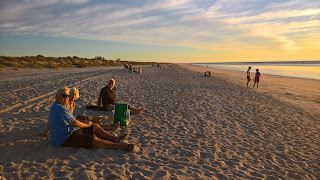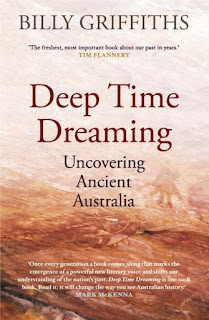Ian wrote this to his niece in Wales responding to her questions about deserts and
outback travel. It seems to me (Helen) a fitting and lyrical piece after this trip of 15,000km to conclude
our blog writing; future trips will be smaller without blogs, although deserts will still be on
the agenda.
It's taken us a week at home to get our router working again, the
wifi and Bluetooth connections firing as they should; back in business! The
moral is don't go away because your technology is no different to your pet. It
needs TLC and regular exercise to keep joints supple!I was dismayed you couldn't get to that response I sent you on the blog, lengthy as it was. It's a Google blog app that like so many things Google now has been tuned back to being close to rubbish. It may be part of Google's big play to strangle everyone who doesn't cave in to their market dominance. They've recently been fined $6bn for bad behaviour. I avoid them when I can.
So I'm going to try and answer those questions again, being - like you on the
beach - basically idle at the moment.
The outback is a special place of course, meaning various things other than deserts; in many respects deserts elsewhere might offer a similar experience, I don't know.
The outback is a special place of course, meaning various things other than deserts; in many respects deserts elsewhere might offer a similar experience, I don't know.

Oz desert is very different to the Sahara. It's also a place that must be totally different in the wet season (up north in the tropical hinterland behind Broome for instance), and further south where the air remains sauna dry. In the winter months it can be freezing at night and mid 20-30C in the afternoons, with generally Wedgewood blue sky day after day. The whole of central Australia and out onto the coast on the NW edge where the pearling industry flourished before the First World War (Broome, where we spent time with family a month ago), and down to the south coast at the Great Australian Bight, is desert. The Great Sandy Desert, the Gibson, Great Victoria, Tanami, Simpson at the centre, and Sturt and Strzelecki in SA. What sets these deserts apart from deserts elsewhere are the sand ridges. They were created during the last ice age about 20k ya. by fierce polar winds that blew constantly across the continent. The ridges bend across the landscape and can be hundreds of kilometres long, creating sinuous bands of alternating claypan and almost luscious vegetation along the ridges; each ridge about 500 metres from the next.
The valleys vary as the underlying geology changes, with abrupt rocky escarpments ("jump ups") that can tower to a hundred metres, part of a wonderful series of ranges that cup and shape the broader landscape. It is far from featureless, it sucks you in.
 The flies that can drive you to distraction (esp. if there are cattle
about - more on that), apparently make suicide seem a sensible option in the
hotter times. They are tiny, about 2-3mm long, and crawl into your eyes and
nostrils regardless of any action you might take. You end up beating yourself
around the face and ears and realise it is a losing battle; so fly nets are
helpful. Generally though we don't have too much trouble with them. As the sun
goes rapidly down they give up and with the place so dry mosquitoes aren't
an issue. The colours in the desert
are extraordinary. Overall it is deep red sand rich in iron oxides, it's basically rusty. The further west you travel, into the
Pilbara region of NW Western Australia, the more purple the rocks and the sand
becomes.
The flies that can drive you to distraction (esp. if there are cattle
about - more on that), apparently make suicide seem a sensible option in the
hotter times. They are tiny, about 2-3mm long, and crawl into your eyes and
nostrils regardless of any action you might take. You end up beating yourself
around the face and ears and realise it is a losing battle; so fly nets are
helpful. Generally though we don't have too much trouble with them. As the sun
goes rapidly down they give up and with the place so dry mosquitoes aren't
an issue. The colours in the desert
are extraordinary. Overall it is deep red sand rich in iron oxides, it's basically rusty. The further west you travel, into the
Pilbara region of NW Western Australia, the more purple the rocks and the sand
becomes.  This is where the iron content can reach 65%, and we are selling it to
China via 2km long trains. Throughout these deserts Spinifex grass grows in
clumps and rings of pale straw colour. Waving seed heads in spring appear
almost white, accompanied with young green tipped growth. As fine as it
appears, desert plant after all, each spine is as sharp as a needle, and
walking through it is not an option. Growing in rings as it does though, you
can navigate comfortably between, where a myriad of other flora create a
wonderland habitat for the birds and little marsupials like the hopping mice.
We have often remarked that in these habitats there is a Garden of Eden still. Certainly
the Aborigines before white invasion knew it as such.
This is where the iron content can reach 65%, and we are selling it to
China via 2km long trains. Throughout these deserts Spinifex grass grows in
clumps and rings of pale straw colour. Waving seed heads in spring appear
almost white, accompanied with young green tipped growth. As fine as it
appears, desert plant after all, each spine is as sharp as a needle, and
walking through it is not an option. Growing in rings as it does though, you
can navigate comfortably between, where a myriad of other flora create a
wonderland habitat for the birds and little marsupials like the hopping mice.
We have often remarked that in these habitats there is a Garden of Eden still. Certainly
the Aborigines before white invasion knew it as such. Sadly though the once common species (mostly nocturnal because of the heat) have now become extinct or nearly so. First the rabbits ate out most of the vegetation up to a certain latitude. They are now "semi-under control" through introduced viruses of one sort and another. But now the feral cat population has all but finished off the marsupials. There is a stat that tells us that 2 million native animals die every night due to feral cats. Then there is the introduced Cane Toad, brought into Queensland in the 1930's to control a weevil in the sugar cane. The weevil lives in the head of the cane, but the toad can't climb. It did nothing except create the biggest extinction of species known. Being poisonous everything that eats it dies. It weighs in at about 100+gms, up to about 3-400, so it's a tempting meal for a Perente Lizard/Goanna or a fresh water crocodile. These species are now reduced to 30% and the toads are still moving westwards across the lower latitudes. Add to that disaster the camel (used for desert communication until the 40's and then abandoned by the Afghanis who drove and handled them, into that garden of Eden to flourish) that is now the most pure bred animal and sought after by the Saudis et al.
 It happily consumes the
bushes and shrubs.
It happily consumes the
bushes and shrubs. Next we have the donkey, the pig, the fox, the feral dog (not the dingo). And then cattle.
Basically things could be better in the bush.
In the Simpson and South Australia there are broad "gibber" plains of
pebbles and rocks polished by the wind born sand, shining as if a sheet of
water. The remains of mountain ranges. The place is so old and it's that
which has made these landscapes unique. Not abrupt and sharp and high, but worn
away, leached, broad, etched horizons far, far away. The vegetation that
adapted survived by putting down roots several metres. Hundreds of thousands of
square kilometres of grassland, esp. in east NT & west Qld where Mitchell and
Blue grasses supports a cattle industry because they say it is 10 times more
nutritious than a mouthful down south, on the river flats. You can see the
glossiest cattle in top condition feeding on Saltbush on the gibber plains,
where you might see one bush (a metre high and around) to the hectare.
They appear out of the mirage, a contradiction to common sense, until you get
how a mountain range of minerals can be leached to one stratum that the flora
can reach.
The sun going down in the West, with often spectacular sunsets, is accompanied
by a deep heather glow in the East. At night time, with a good moon,
light reflected off the red sand colours shows the night sky a rose pink.
There
is a deep silence as the wind drops away. The stars, unaccompanied by moon, are
a background of light splashed across by the milky way, tilting further and
further as the night goes by. There are so many stars it is difficult to find
the familiar constellations. The patterns of gas clouds are clear, the only
movement perhaps a satellite eerily slipping past. Later, there are scratchings
and scrapings occasionally and perhaps the sound of a dingo snuffling in the
waste bag, or more likely, calling to its mates from a high point, to hear
where they are. They will move in a pack but are usually on their own.

In the
morning, chill until the sun is up, there might be a family of camels, curious
and wary at the same time, a hundred metres away. The male is pissed off and
tries to humble us with a display of stroppy behaviour as he ushers his harem
away. The Pied Butcherbird song is the most beautiful of the dawn chorus.
The outback is many things, long billabongs overhung by Bloodwood and Melaleuca trees, spectacular gorges, or a featureless, flat expanse that can send a shiver through you. It is a place that can grab you in an almost visceral way, full of often painful history, the sort of place that changes people.
 |
| Balgo WA |






























